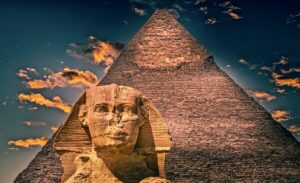
In about 2550 BC, the Old Kingdom Egyptian pharaoh Khufu erected his massive pyramidal sepulcher and mortuary temple on a rocky plateau at Giza, on the west bank of the Nile. By any standards, the building of Khufu’s pyramid complex was a staggering achievement and a masterpiece of careful administration and planning. Thousands of skilled and unskilled workers toiled for the benefit of a single man. To the Egyptians of the time, he was the living embodiment of the sun god Re. His successors, Khafre and Menkaure, emulated him. The pyramids of Giza were the supreme achievement of Old Kingdom Egypt, built on the belief that the pharaoh was the foundation of a prosperous world.
In Old Kingdom Egypt, everything depended on the power and spiritual authority of the king. According to Egyptian belief, he was destined to take his place among the gods upon his death. Even before death, however, Old Kingdom pharaohs were living deities, the very essence of divine order in a prosperous world nourished by a bountiful river, the Nile, with its predictable annual inundation. They were symbols of the equilibrium between the forces of order and chaos, of the stability that had sustained Egypt for centuries. For more than four hundred years, Egypt prospered under the rule of despotic pharaohs like Khufu, who ruled like divine kings. Old Kingdom rulers were a blend of force and intelligence, nurture and fear, sustenance and punishment. They were lucky, for they presided over the state during centuries of bountiful flooding that was as predictable as the rising and setting of the sun—the sun god Re—who maintained the verdant kingdom.
Many people assume that the Nile provided Ancient Egypt with plentiful harvests every summer. This was akhet, the inundation that arrived early in the summer. The Nile waters rose, spread over fertile soils of the floodplain, then receded. Egypt’s farmers planted their crops as the water retreated, harvesting enormous grain surpluses that supported the pharaoh’s court in all its magnificence, fed the work teams that built pyramids and temples, and supported the king’s bureaucracy and armies. The cycle of Nile farming life repeated itself seemingly endlessly, supporting one of the world’s earliest pre-industrial civilizations. Wrote a Victorian irrigation expert, William Willcocks, who worked along the Nile in the 1890s: “The Nile looms very large before every Egyptian and with reason.” What is often forgotten is that the average flood plain relief is only about two meters. A rise two meters below average could leave up to three-quarters of some Egyptian nomes (provinces) totally unirrigated.
Thus, for over two-and-a-half centuries, Khufu’s successors ruled over a relatively small population with plenty of farmland to go around. Their rulers fostered the belief that they controlled the inundation, the foundation of human existence. What they did not know was that that their splendid kingdom’s food supplies depended on the Indian Ocean and the whims of El Niños in the distant southwestern Pacific. Though successful pharaohs ruled with near-despotic powers, working well in times of plenty, the good times could not last. A combination of factors would spell trouble for Egypt on the horizon………………
_______________________________
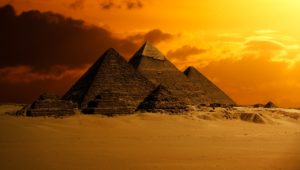
The great pyramids on the Giza Plateau, including the pyramid of Khufu, are perhaps the most iconic images of ancient Egypt today. Soupysquirrel, Pixabay, Public Domain
_______________________________
Pepi II: The Ineffectual Pharaoh
Pepi II was the last of the major Old Kingdom pharaohs. He ascended the throne in 2289 BC at the age of six. By the standards of some of his predecessors, he was an ineffectual ruler. His main claim to fame is the length of his reign. According to the Greek historian Manetho, he ruled for a staggering 94 years, but the length of his reign is disputed and was probably significantly shorter. Whatever the amount of time Pepi spent on the throne, he was certainly in power for a very long time, perhaps longer than any other pharaoh. The officials who buried him named his surprisingly modest pyramid “Nefer-ka-Re [Pepi II] is Established and Living.” At first, a regency council of close relatives advised him, at a time when his predecessors had decentralized some governance. This turned out to be mistake that Pepi was unable to correct. He surrounded himself with what appear to have been officials with little concern for the state. As the years passed, real political power passed gradually to senior officials, whose bases were in the nomes.
Pepi ruled at a time when life expectancy was no more than twenty-five to thirty-five, so his regal experience was impressive and theoretically invaluable as he ruled by precedent. At his accession, Egypt was immensely powerful, very wealthy, and probably somewhat complacent. The court in Memphis enjoyed a long-established royal monopoly on trade in ivory and tropical projects with Nubia far upstream of the First Nile Cataract at Aswan. Pepi also controlled the long-established timber trade with Byblos in what is now Lebanon on the eastern Mediterranean coast. But the pharaoh lost authority steadily, as his provincial administrators usurped more and more civil and religious offices, even individuals as lowly as local magistrates. Their tomb inscriptions proclaimed them holders of such offices as “overseer of Upper Egypt in the middle nomes” or “god’s seal bearer.” Their concern was a happy and influential eternity, not the welfare of the pharaoh’s domains.
Unfortunately, the ineffective Pepi ruled in turbulent times. Thirty years into his reign, a Mesopotamian king, perhaps the celebrated King Sargon of Babylon, sacked Byblos and destroyed a major source of Egyptian wealth. At the time, Pepi was spending enormous sums on foreign expeditions. Throughout his long reign, Egypt’s authoritative grip over neighboring lands became progressively weaker, especially upstream of the First Cataract, in Nubia. A powerful coalition of Nubian kingdoms threatened long-established trade ties. By now, the pharaoh was older and progressively less effective, not the more decisive ruler of earlier decades. At home, the pharaoh had long worried about his ambitious and increasingly powerful nomarchs. They were his tax and tribute collectors, and assembled military levies. Some of their loyalty became suspect, so he resorted to appeasement by lavish distributions of wealth. The nomarchs trimmed their sails to the political wind as long as the pharaoh had close control of his domains. But as he grew older and became more detached from the business of governance, the nomarchs increasingly aped the pharaoh and built themselves elaborate tombs in their provinces. A strong and decisive leader might have avoided trouble, but Pepi had outlived most of his sons, which may have meant that the succession was in dispute. The succession was always an unseen elephant in the political room, as factions of courtiers, and even the king’s sons, jostled for power. As the years passed, the monarchs became bolder, more powerful, and less respectful of Memphis. With Pepi’s demise, Egypt would face disruptive chaos.
The pharaoh died in about 2184 BC and was buried in a magnificent pyramid. His oldest son and successor, Merenre II, did not last long. Economic and political chaos ensued. The Greek historian Manetho writes of seventy rulers who reigned for seventy days, more a reflection of chronic instability than historical reality. High officials competed for power. In the end, Pepi’s descendants still ruled from Memphis, but their domains rarely extended beyond the city’s boundaries and they failed their people.
________________________________
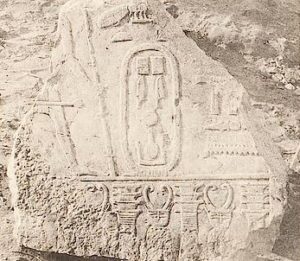
Relief of Pepi II from the temple of Min in Coptos; Petrie Museum, London, UC 14281. Wikimedia Commons, Public Domain
________________________________
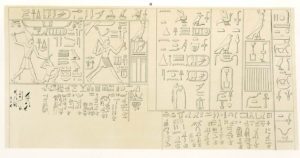
Rock inscription of Pepi II at Wadi Maghara, Sinai. Karl Richard Lepsius (1810-1884), Wikimedia Commons, Public Domain
________________________________
The 4.2 ka Event
This was the moment when the Great Megadrought of c. 2200 to 1900 BC descended over vast areas of the world. An unprecedented arid cycle known to climatologists as the 4.2 ka Event, descended on human societies from the Americas to Asia, from the Middle East to Europe and tropical Africa. Today, evidence of the megadrought can be discerned in lake sediments from Iceland and Greenland and in European tree-rings. High-resolution stalagmite growth rings from Turkey, Iran, and India document the drought as the Indian monsoon faltered. For example, a stalagmite sequence attestation from Mawmluh Cave in northeastern India links falls in East African lake levels, also much reduced Nile inundations with deflections of the Indian monsoon. The unstable East Asian monsoon created stress for well-established farming communities in eastern China. Thus, the megadrought rippled across kingdoms, prosperous civilizations and rural landscapes, with catastrophic economic and political effects on Egypt.
The Egyptian state depended on carefully directed, authoritarian leadership from Memphis, ample floodwaters. and a close, cooperative relationship between the pharaohs, his nomarchs, and high officials. With these ingredients in place, Egyptian civilization worked well in well-watered years. But it was highly vulnerable to long-term drought, which was virtually unknown during the reigns of Pepi II and his forebears. Today, numerous climatic proxies discovered in the region of ancient Egypt, indirect records of climatic change, document the onset of the 4.2 ka Event as it impacted Egypt. Lake Tana in Ethiopia, one of the Nile sources, has produced freshwater cores that record a serious dry spell in 2200 BC. Brine sediments in the Red Sea hint at a major drought at the same time. A core from Saqqara in Lower Egypt reveals a meter of dune sand overlying formerly arable fields. A series of low floods cut off Lake Qarun in the fertile Fayum Depression west of the Nile from the great river. Even tree-rings lifted from a cedar coffin reveal a drought from 2200 to 1900 BC.
These sudden, catastrophic long-term declines in the inundation caused almost immediate famine and paralyzed well-established political institutions. The pharaohs had long proclaimed their mastery over the capricious Nile and its inundations. They were, after all, gods. But the people were hungry. Stored grain ran short, as a revolving door of incompetent rulers cycles through the court at Memphis. There were repeated famines for three centuries. Desperate farmers planted their crops on river sandbanks. Inevitably, with little central control, Egypt fractured and became a patchwork of competing provinces in the hands of ambitious nomarchs, some of whom ruled like monarchs. Centuries later, a seer named Ipuwer lamented the incompetence of the pharaohs of the day: “Confusion is what you set through the land, also the noise of tumult.”
______________________________
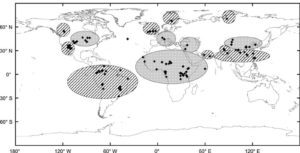
Global distribution of the 4.2 kiloyear event. The hatched areas were affected by wet conditions or flooding, and the dotted areas by drought or dust storms. Another map for reference in (15 April 2018). “The timing, two-pulsed nature, and variable climatic expression of the 4.2 ka event: A review and new high-resolution stalagmite data from Namibia”. Quaternary Science Reviews 186: 78–90. DOI:10.1016/j.quascirev.2018.02.015. ISSN 0277-3791. Jianjun Wang, Liguang Sun, Liqi Chen, Libin Xu, Yuhong Wang & Xinming Wang, CC BY-SA 4.0, Wikimedia Commons
______________________________
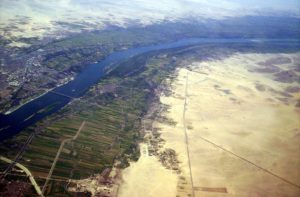
Fertile, well-watered land abutting the Nile near present-day Luxor, Egypt. Anciently, agriculture in Egypt was also much dependent on the condition of the Nile. Bionet, Wikimedia Commons, Public Domain
______________________________
Ankhtifi and Khety the nomarchs
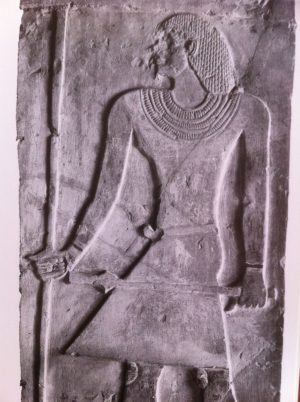
Ankhtifi from his tomb at el-Mo’alla. Роман Курносенко, Creative Commons Attribution-Share Alike 4.0 International license, Wikimedia Commons
Fortunately during these trying times, some nomarchs were competent administrators. They boasted of their achievements on their tomb walls, perhaps not a reflection of reality. Ankhtifi of Hierakonpolis and Edfu, two of the southernmost nomes of Upper Egypt, had such a high opinion of his military abilities and of himself that he called himself the “great chieftain.” He became nomarch just as low floods became commonplace. “All of Upper Egypt was dying of hunger,” his tomb inscriptions tell us. There were reports of cannibalism, of people eating their children; his province becoming like “a starved grasshopper.” As so often happened in famines everywhere, hungry villagers wandered aimlessly in search of food and people fought over water. People were so hungry that they were said to be eating their children. “I managed that no one died of hunger in this nome,” he claimed, as tomb-robbers plundered the dead. Ankhtifi’s grandiloquent inscriptions boasted of loaning precious grain to people upstream, of forbidding the nome’s inhabitants to leave. The nomarch ruled like a pharaoh. “I am the beginning and the end of humankind, for my equal has not and will not come into being.” Fortunately, he controlled food supplies, imposed rationing, and erected temporary dams to impound water. These short-term measures worked and saved many lives, for his leadership was decisive and based on hard-earned local knowledge.
By any standards, another nomarch, Khety II of Assiut, was well connected. He grew up at the royal court and boasted in his tomb inscriptions that he learned swimming with the pharaoh’s children. Young Khety grew up during prosperous times, when brimming Nile floods irrigated the fertile lands around Assiut. Profoundly loyal to the pharaohs, he rose to become nomarch of Assiut, a tax collector and powerful administrator who served as the king’s representative in his nome, a province far upstream from the court at Memphis. But the good times were over. Flood after flood peaked quickly, at much lower levels than before. Thousands of hectares of normally fertile soil received no water from the usual inundation. In desperation, villagers planted crops on sand banks exposed by the receding water. Khety soon found himself confronted by famine. Though unlike many Egyptian officials of the day, he was a proactive administrator, who paid careful attention to impending flood levels predicted by his scribes. His sepulcher boasted of the drastic measures he took to feed his people: “I nourished my town, I acted as [my own] accountant in regard to food and as giver of water in the middle of the day.” He dug a canal 10 meters wide to divert precious irrigation water to drought-stricken farmland. Like Ankhtifi, he built dams, drained water from swamps for irrigated lands, and rationed grain, placing guards on grain bins.
______________________________

Facsimile of the paintings on the north wall of the burial crypt in the tomb of Khety. Wikimedia Commons, Public Domain
______________________________
Transformation
Despite these efforts, the fragile unity of the state collapsed. By 2040 BC, bitter rivalry between the ruling family at Thebes and rivals in Lower Egypt led the south to split off into a separate kingdom. Constant border clashes marked the frontier between the two domains as Thebes tried to conquer its northern rivals. In 2060 BC, Mentuhotep I became ruler of Upper Egypt. He reigned for a half-century, the early years of his reign marked by bitter fighting with northern rivals. Mentuhotep put down rebellion by the city of Abydos, relatively close downstream, with great severity in 2046 and reunited Egypt under his rule. He became known as the “Uniter of the Two Lands.”
Thus began the Middle Kingdom of Egyptian history, two-and-a-half centuries of prosperity and abundance. There were periods of low floods, but nothing approaching the great hunger. Mentuhotep and his successors presided over a strongly centralized state during years of exceptionally high floods. They also learned from earlier centuries that the doctrine of an infallible pharaoh was unsound. They proclaimed that the sun god Re had charged them to establish the philosophy of ma’at, “rightness” on earth, a philosophy that did allow for a king’s failure. Middle Kingdom pharaohs saw themselves as shepherds of the people, more concerned with the common welfare than their predecessors. They were also efficient administrators who imposed a firm bureaucracy on every aspect of Egyptian life, including irrigation and grain storage. None of them forgot that their power, as guardians of the natural order of things, depended on the erratic Nile inundation. Middle Kingdom artists depicted their rulers not as eternally youthful monarchs, but as careworn rulers of brooding seriousness.
_____________________________
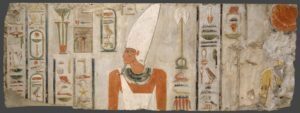
A Block from the Sanctuary in the Temple of Mentuhotep II at Deir el-Bahri. Made during the Middle Kingdom in Dynasty 11, during the reign of Mentuhotep II. Found at Egypt, Upper Egypt; Thebes, Deir el-Bahri, Temple of Nebhepetre Mentuhotep, EEF 1907. Wikimedia Commons, Public Domain
_____________________________
There were still periods of political uncertainty when floods were low, but the different provinces now cooperated more closely in times of trouble, while technological innovations like the lever-operated shaduf allowed farmers to irrigate their land outside the flood season. The best and most powerful pharaohs prospered because they deployed their subjects to create an organized oasis out of natural bounty. This produced far larger food surpluses than subsistence needs, enabling them to become godlike managers of an agricultural state that supported an ever-rising urban and rural population. They were successful. Despite occasional vicissitudes, ancient Egypt prospered until Roman times.
Cover Image, Top Left: The Digital Artist, Pixabay, Public Domain


